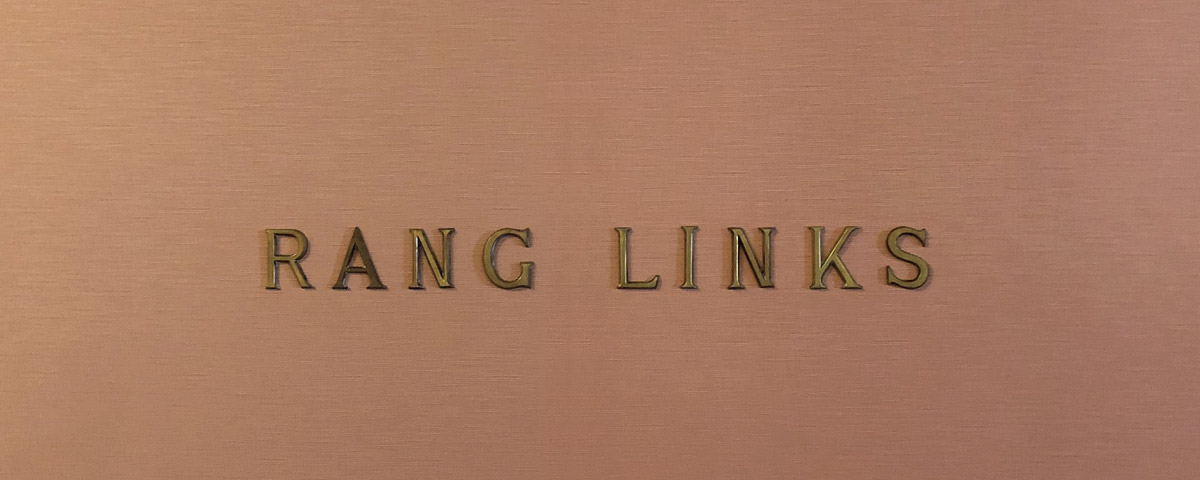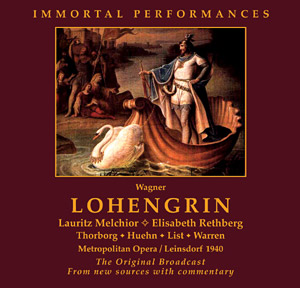
Großes Festspielhaus, Salzburg (Detail).
© Thomas Prochazka
[EN] Immortal Performances:
“Lohengrin” (Metropolitan Opera, 1940)
Von Thomas Prochazka
The other two sets date from 1934 — the first ever complete Metropolitan Opera (Met) broadcast, also with Rethberg and Melchior, only issued on the Immortal Performances Recorded Music Society label in April 2019 (IP 1112-3) —, and from January 17, 1942 (IP 1107-3), with the young, impressive Astrid Varnay opposite Melchior and, to some, the best performance of the Graf von Telramund ever heard by Herbert Janssen as well as the best Ortrud from Kerstin Thorborg (better than 1940, they say).
II.
I chose the recording of 27 January 1940 for several reasons:
- The 1940 Lohengrin set is complete without any substitutions.
- I hoped for a better recording quality than in 1934 or 1935.
- Both the 1934 and the 1935 broadcasts came with ruinously damaged or missing parts which had to be substituted by Richard Caniell, the sound engineer of Immortal Performances, from later broadcasts.
- In the original radio broadcast from 1937, the Belgian René Maison sang the title role. (Since Flagstad and Melchior sang together in performances for years, but never in a Saturday matinée — or the tapes were not archived by the NBC, respectively —, Caniell replaced Maison in painstaking detail with Melchior from a 1938 Met recording).
- I was curious about Elisabeth Rethberg’s rendition of the role of Elsa (after the Salzburg Don Giovanni from 1937).
- Kerstin Thorborg, although one of the greatest Wagner contraltos (not only) of her time, is widely unknown to many of us today.
III.
As is customary with the publications of the Immortal Performances Recorded Music Society, sound engineer Richard Caniell informs in the accompanying CD booklet about the (mostly sonics-related) technical obstacles that had to be overcome in order to be able to publish the said performance. The recording of 27 January 1940 had already been released 15 years ago. The present, second publication of this performance is based on the original tapes of the transmission. (But don’t worry, there was still enough to do for Caniell).
The result is worth hearing: With the exception of the first act prelude, this release offers a sound quality that is astonishing for its time. You hear the overtones in the voices, clarinet and oboe are amazingly present in their solos, distorted sounding passages (if, then especially in the choir/ensemble scenes) are rare.
IV.
This Lohengrin recording offers something astonishing: First of all, there is the young Leonard Warren as the Heerrufer. From the first note, Warren impresses with his dark baritone, his legato and a text clarity that makes every word understandable. (And vocally outshines Dietrich Fischer-Dieskau, the Graf von Telramund of the Kempe recording of 19641, by far.)
On this Saturday in January 1940, Warren also outdid Emanuel List as König Heinrich. Certainly, List had no major difficulties with his role or the “money notes” at the top and bottom. But his voice often sounds flat. Not as awe-inspiring as we would expect from a king. Warren’s voice on the other hand: darker than that of his bass colleague, more open, with greater volume.
V.
Second, the Graf von Telramund of Julius Huehn (also only 27 years old). Huehn, born in Revere, Massachusetts, had studied with Friedrich Schorr. Huehn was an erudite student: He sang the Graf von Telramund in a very natural, soft German, almost without any accent. A German that should put many of today’s interpreters to shame. When was the last time we heard a Graf von Telramund sing (almost) parlando; paying such close attention to the notated eighth and sixteenth notes? On the recording, Huhn’s voice does not sound as big as that of his colleagues. Nevertheless: This nobleman doesn’t need to fear any comparison with today’s interpreters. His voice is immensely present. Also (or even more so) in the second act, in the big scene with Ortrud.
VI.
The third discovery of this recording is the Ortrud of Kerstin Thorborg. Her performance could not have been an easy task as she had to replace the originally scheduled Karin Branzell at short notice on January 27, 1940. The Swedish contralto possessed an outstanding, technically trained voice. The pronunciation of the text is beguiling. The top notes are organically embedded in the phrases, not reached overusing portamenti or — as is usually the custom today — presented forte, with involuntary changes of the voice’s color. Thorborg, like Elisabeth Rethberg, knows how to mix the two voice families imperceptibly; even when the voice has to descend to the low ‘c’. The clarity of the tone: It is still present.
VII.
With Lauritz Melchior, this Lohengrin recording offers one of the best Heldentenors whose work is still accessible to us today. Melchior sang the title role at the Met with various partners from 1935 well into the 1940s: in 1935 with Lotte Lehmann, in 1937/38 repeatedly with Kirsten Flagstad (though never in a matinée broadcast), and in the present recording with Elisabeth Rethberg.
Melchior’s Lohengrin never puts himself into the center stage. Nevertheless, his Heldentenor voice has a vocal presence that leaves one filled with amazement. Jess Thomas cannot keep up with it on the studio recording under Rudolf Kempe (formerly EMI, now Warner Classics). Where Thomas lets us hear the necessary vocal power, Melchior, it seems, never runs out of reserves.

Richard Wagner
»Lohengrin«
Lauritz Melchior · Elisabeth Rethberg · Kerstin Thorborg · Julius Huehn · Emanuel List · Leonard Warren
Chorus and Orchestra of the Metropolitan Opera
Erich Leinsdorf
Immortal Performances IPCD 1018-3
Available at www.immortalperformances.org
Melchior’s Gralserzählung (the story of the Holy Grail) follows Wagner’s dynamic guidelines only in parts. But what power Melchior brings to, how impressive he vocally shapes this scene! What great experience with a role does it take to make such decisions? And perhaps even to adapt them evening after evening, based on one’s vocal condition?
VIII.
Elisabeth Rethberg sang the role of Elsa at Melchior’s side. And what an Elsa this was! Elisabeth Grümmer may have been the greater artist (even if her top notes on the Kempe recording sometimes sound sharp and separated from her middle voice at some times), Rethberg was the better singer. How this Dresden-born singer shapes the phrases, pays as much attention to the dynamics as to Wagner’s demanded portamenti, will probably secure her a place in the “Singer Olympus” forever. Rethberg’s voice seems to know no technical limits: Where Wagner wrote a fermata in the middle of a phrase, Rethberg ended the phrase without taking another breath after that held note. Who of today’s singers is able to do this? Listen, for example, to how Rethberg takes the voice back into the pianissimo in the second act, in the phrase “ein Glück das ohne Reu’!”
IX.
The 27-year-old Erich Leinsdorf took the conductor’s stand in front of the Metropolitan Opera orchestra. Leinsdorf, born in Vienna in 1912, had been recommended to Arturo Toscanini by Bruno Walter to become the assistant in the former’s productions at the Salzburg Festival. Finally, Leinsdorf ended up as Artur Bodanzky’s assistant at the first U.S. opera house. (Bodanzky was “the” conductor for the German repertoire at the Met in those years.)
Leinsdorf conducted a spirited performance marked by youthful buoyancy with the cuts apparently common at the time: König Heinrich did not need to tell about the Hungarians in the first act. Two choir/ensemble scenes in the finale of the first and second act were shortened. And in the third act, the ensemble scene after the Gralserzählung up to Lohengrin’s “Schon sendet nach dem Säumigen der Gral!” fell victim to the red pencil (a cut that is still quite common today, e.g. in Christian Thielemann’s Dresden performances in May 2016).
The immediacy and freshness of Leinsdorf’s direction shall be demonstrated by two examples: Neither Kempe nor Thielemann2 manage to conduct the finale of the first act in such a sweeping manner. The same applies to the prelude to the third act: Where Kempe and Thielemann slow down the tempo in the quieter middle section, Leinsdorf continues to storm forward in a very lively manner, observing Wagner’s marking Sehr lebhaft. Only in the finale, for a smooth transition to the bridal chamber scene, Leinsdorf takes a more moderate tempo, too.
X.
This Lohengrin recording from 80 years ago is a recommendable addition to any CD collection. And a vivid example of what the great singers of the past were able to achieve.
(Remarks: An earlier version of the article omitted information about the Immortal Performances Lohengrin sets from 1934 and 1942. Also, a few unclear phrases have been corrected.)
- Richard Wagner: Lohengrin. With Elisabeth Grümmer, Christa Ludwig, Jess Thomas, Dietrich Fischer-Dieskau, Gottlob Frick, Otto Wiener. Rudolf Kempe conducts the Vienna Philharmonic Orchestra and the Vienna State Opera Choir. Warner 0 825646 902569 (3 CD), 1964. ↵
- I refer to the unedited recording of the performance at the Semperoper Dresden on May 22, 2016, available to me, with Anna Netrebko, Evelyn Herlitzius, Piotr Beczała, Tomasz Konieczny, Georg Zeppenfeld, Derek Welton and the Sächsischer Staatsopernchor Dresden. Christian Thielemann conducts the Sächsische Staatskapelle Dresden. ↵